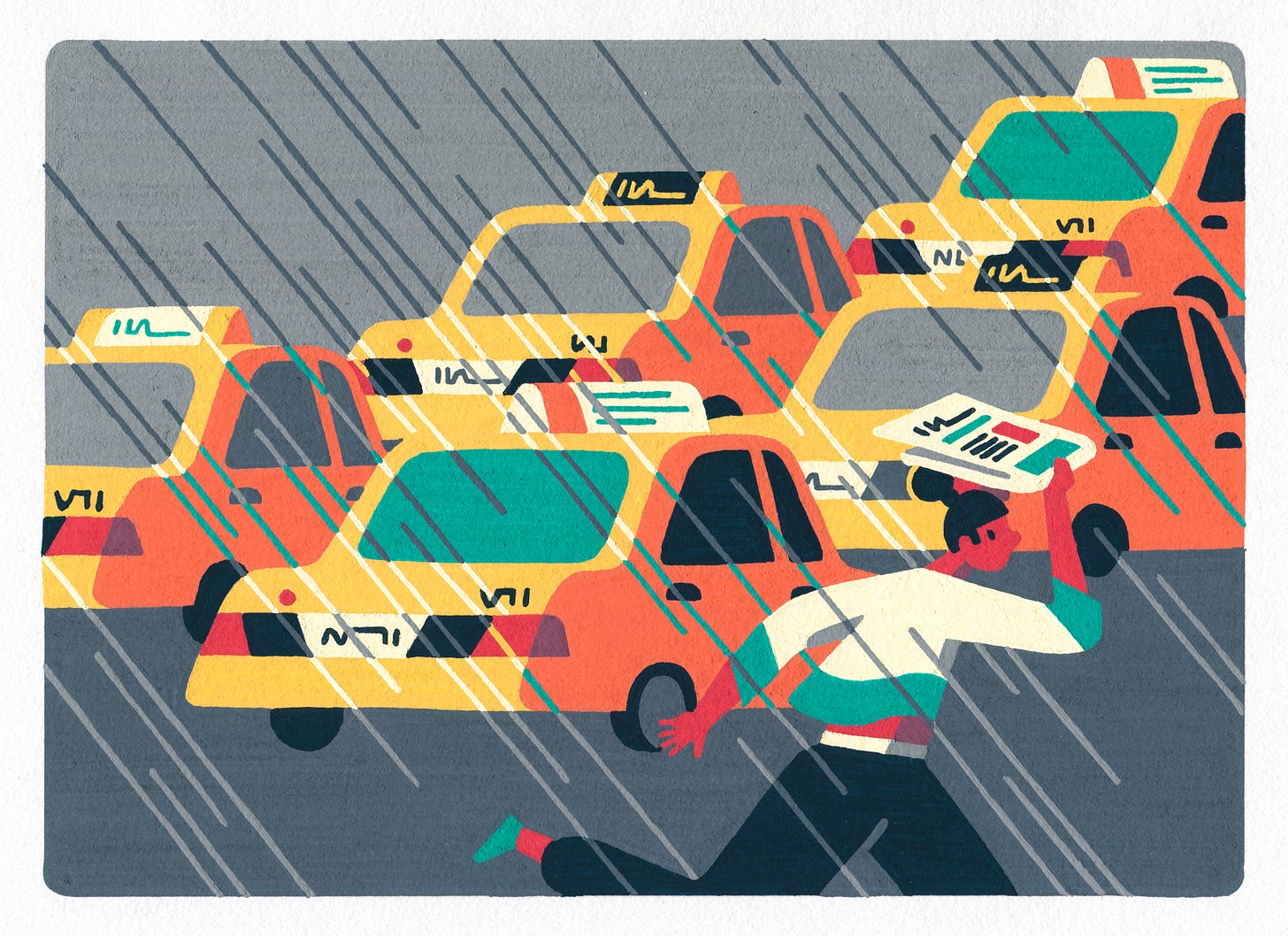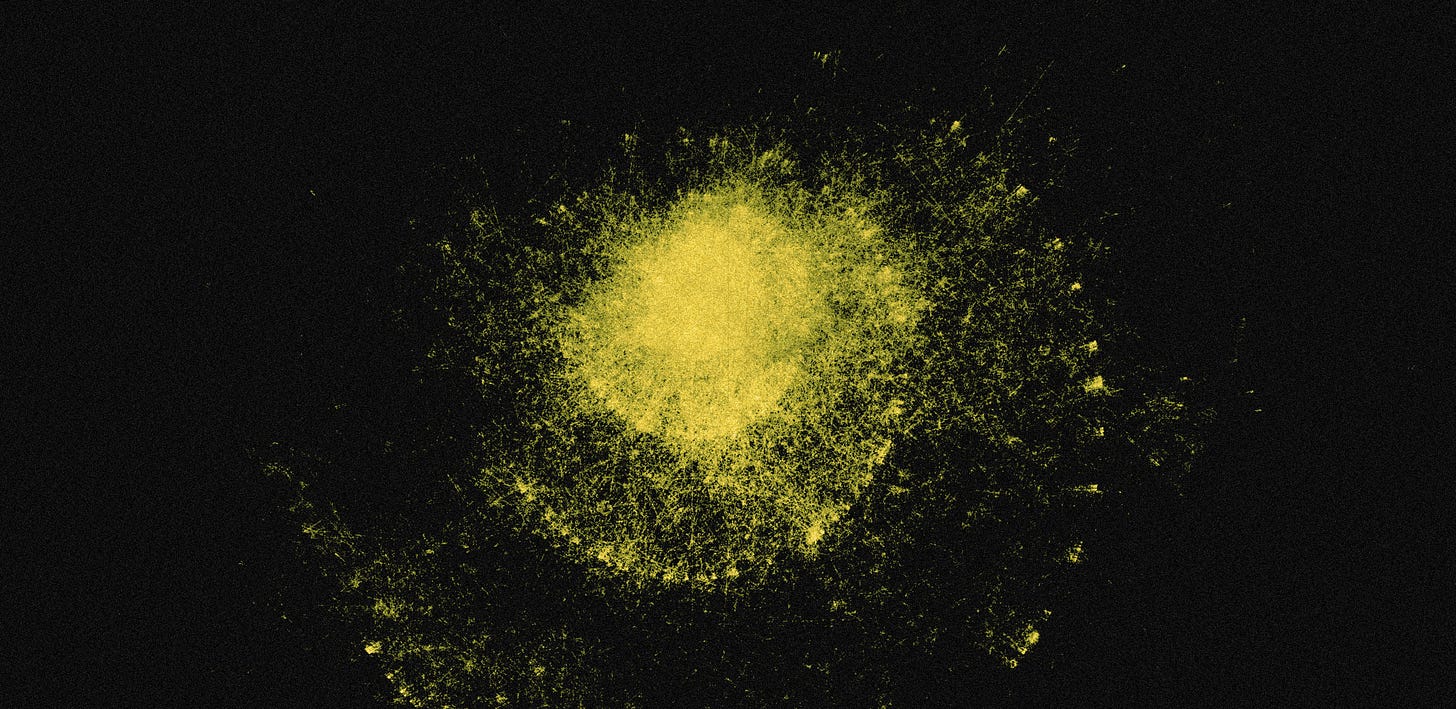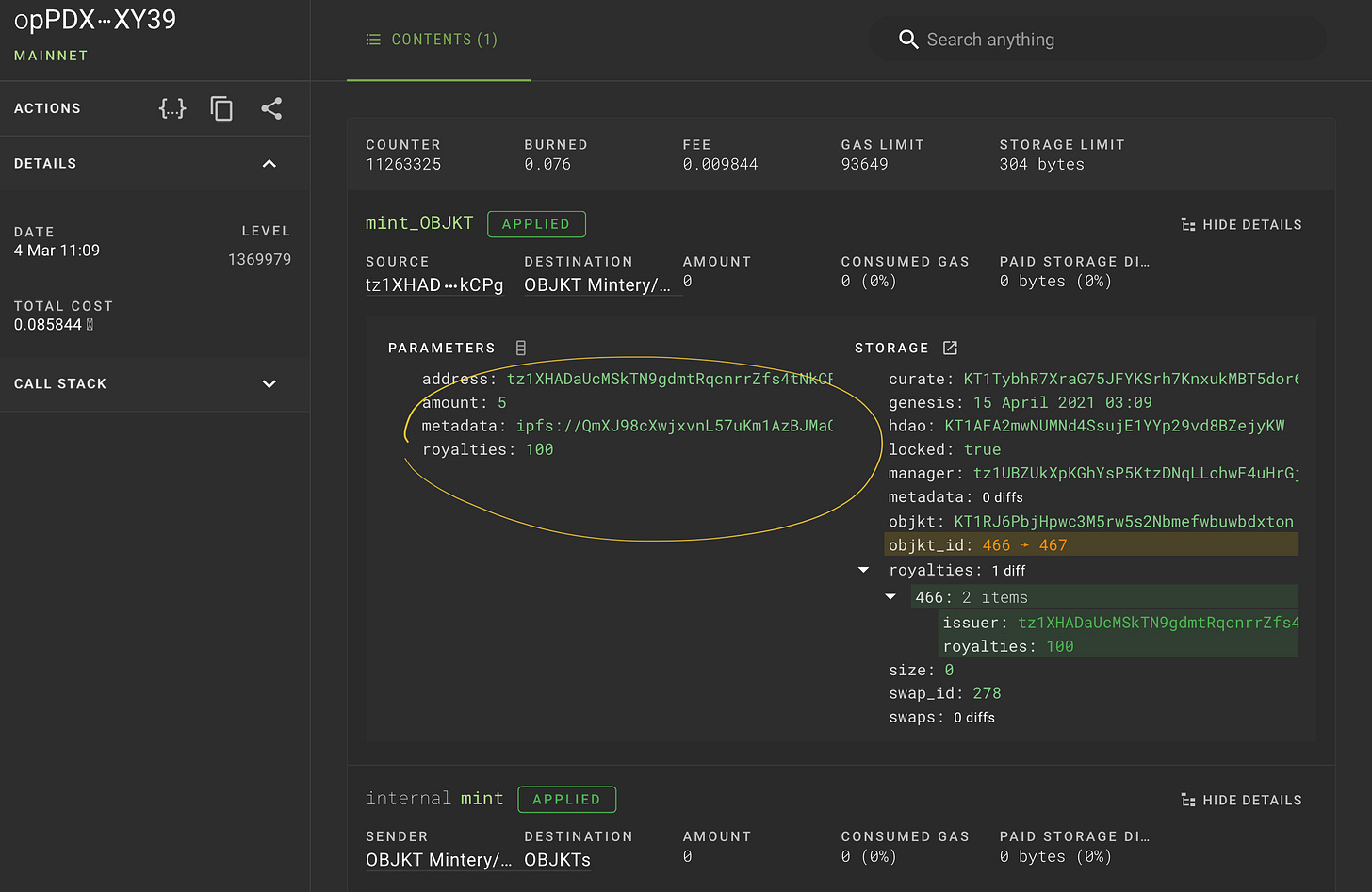Hicetnunc and the Merits of Web3
experimental protocols in decentralization and distributed hosting
For those unaware, hicetnunc.xyz was an online, open-source, and community-driven digital art marketplace built atop the energy-efficient Tezos blockchain. Since its early beginnings in 20211, the project has grown dramatically, supporting thousands of artists across the globe, and has notably become an important platform for those in the global south. Largely created by one developer, Rafael Lima, and a loose group of volunteer contributors2, it has been an amazing, if haphazard, experiment in decentralization and distributed design in the ethos of “web3,” a poorly-termed yet novel paradigm of building web applications atop decentralized public blockchains.
The sprawling ecosystem spawned by this platform and its thousands of users now encompasses many different websites, marketplaces, tools, sub-communities, and ideals. It’s quirky nicknames—HEN, H=N, Nunc, “Hic”—have come to represent a sort of slang of shared goals and philosophies around the future of digital art distribution, hosting, and ownership, rather than simply an abbreviation of an obscure domain name. Underpinning this ecosystem is a database of over half a million “OBJKTs”—unique tokens on the Tezos blockchain that point to different media files, typically representing digital artwork that artists are selling and trading for XTZ (the native token of the Tezos cryptocurrency).

The Sudden Death of H=N
Sadly, on November 11th, 2021, Rafael decided to suddenly pull the plug on hicetnunc.xyz and its online presence, in what appears to be a kind of rage-quit reaction to seeing other platforms co-opting and colonizing his ideas. This marks the death of the website, and perhaps the end of Rafael Lima’s involvement. Yet, the overall community spirit, as well as its tokenized assets and media files, appears largely unaffected. A suite of forks and competing platforms have sprung up in its wake, and much of the community has come together across various forums and online channels to regroup and reorganize their efforts3.
This unexpected shuttering of the website is proving to be a real-time stress test for decentralized applications (“dApps”) and the lofty claims of web3: an idealized vision where users remain in control of their content and assets, rather than locking it into a centrally owned platform (Instagram comes to mind). And, in the case of HEN—an ecosystem built on a radically different set of paradigms and technologies than what we have previously been exposed to on the web—these pillars of decentralization seem to be working.
Distributed Assets
On March 4, 2021, I uploaded and “minted” my first OBJKT through Hicetnunc, spanning tree sketch 01, as an edition of 5 limited tokens. These tokens, cryptographically signed by me (the artist) and pointing to a particular generative artwork of mine, have been completely unaffected by the website’s shutdown. The records of ownership and provenance continue to be upheld by the distributed public ledger of the Tezos blockchain, and each token still sits comfortably in their respective owner’s wallets. Owners can continue to trade their tokens just as before: through smart contract interactions triggered by a web interface (such as a HEN fork, an alternative online marketplace, or via localhost), or simply peer-to-peer, sending them from one wallet to another.

Beyond the blockchain tokens, the user content and media that collectively makes up the HEN ecosystem—images, videos, music, real-time artworks, and more—has also survived largely unscathed. OBJKTs are initialized with an immutable metadata string as part of the mint operation (a transaction that cost me about 0.08 XTZ, or $0.30 USD), and any website interface can query this data from the token contract.
This string represents the addressable hash of a JSON file, hosted in a distributed manner via IPFS—where I am one of the nodes, among others4, helping to seed or pin the content of my artwork over the network. The JSON metadata includes a title, description, and additional hashes for the media and its thumbnail image, which are also hosted in the same manner.
You can view this metadata and image through an IPFS gateway such as Cloudflare, or if you have IPFS installed you can access the file directly from other peers:
ipfs://QmXJ98cXwjxvnL57uKm1AzBJMaCw4ykYejUt3JoKrZgnNc
And this is how, despite the Hicetnunc.xyz website shutting down, its users and their content are able to transition seamlessly to alternative platforms and online spaces, because the website was merely acting as a thin interface atop the decentralized blockchain contracts and peer-to-peer file hosting. My OBJKT #466 can still be displayed, listed, and traded via community forks such as Hicathon and Teztools, or alternative marketplaces such as Objkt.com.
Token Contracts
The OBJKT token contract (KT1RJ6PbjHpwc3M5rw5s2Nbmefwbuwbdxton) that facilitates all the assets minted and traded within the HEN ecosystem, albeit deployed by Rafael, appears no longer within his control to modify, pause, or destroy5. Other contracts, including the Minter (KT1Hkg5qeNhfwpKW4fXvq7HGZB9z2EnmCCA9) and Marketplace (KT1HbQepzV1nVGg8QVznG7z4RcHseD5kwqBn) are also largely outside of his control to dismantle, and can continue to be used as per normal, presumably for as long as the Tezos blockchain remains usable.
However, a 2.5% manager fee on each “swap” (a trade facilitated by the Marketplace contract) is still sent to Rafael’s wallet—and this is one aspect of the contract he can still alter. New web interfaces looking to support trading OBJKTs will likely want to use an alternative Marketplace contract to facilitate swapping, such as one not owned by any central party (perhaps owned by a DAO, multisig wallet, or burn address).
Update Nov 14: Rafael now seems to have lowered the manager fee on the Hicetnunc Marketplace contract to 1%.

Collection & Stewardship
Looking forward, I may or may not decide to mint new work through Hicetnunc’s OBJKT token contract in the future. It’s there, it’s possible, and it’s not going anywhere, but I’d like to wait for the dust to settle and see whether the community decides to rally around alternative contracts in the coming months. The media files for my 21 minted OBJKT tokens will continue to be pinned by my own local IPFS node, a Pinata cloud service, and hopefully by other owners and stewards of my work.
I have always felt the strength of the “web3” space lies with programmable smart contracts, and the ability to define standards-compliant tokens on a decentralized ledger; allowing this work to be indexed, displayed, owned, traded, and organized across a multitude of competing web interfaces. I’m excited to mint new work through other token contracts on Tezos, and at some point develop and deploy my own contracts, and watch as this new work becomes easily organized and displayed alongside my older Hicetnunc-minted OBJKT tokens.
In terms of my collection (tz1XHADaUcMSkTN9gdmtRqcnrrZfs4tNkCPg), which has grown to encompass over 250 OBJKTs from a diverse range of artists (primarily across generative art and illustration), I’ll do my best to continue to pin and maintain it, as I feel my stewardship provides a valuable utility in ensuring this digital art remains accessible online, and in higher resolution than what many centralized platforms typically offer.

Perhaps not surprisingly, the shutdown of the Hicetnunc.xyz frontend won’t stop me from continuing to collect more OBJKTs and other artist-minted tokens from other forks and marketplaces, and I suspect many other collectors feel similarly.
Competing Marketplaces & Ideologies
One of the novel aspects of the web3 paradigm is that the source of truth is maintained by the public and decentralized blockchain, and various centralized web platforms will often then compete on the same user data. Even over the last several months, alternative marketplaces have emerged on Tezos with sometimes different goals and ideals that support OBJKT displaying and trading outside of hicetnunc.xyz.
One such example is Objkt.com, a more user-friendly albeit closed-source marketplace that aims to facilitate trading a wide range of Tezos FA2-standard tokens, rather than only Hicetnunc’s OBJKT tokens (one might wonder why they decided to name their platform after Rafael’s contract; it feels almost like an act of colonization). The UI design, showing “Top Collections” ranked by price and “Ending Soon” auction countdowns, is a stark ideological departure from Rafael’s bottom-up and art-centric design.
I personally see this fragmentation of ideas and competing approaches as healthy, as it implies a wider range of protocols and platforms are being built atop the decentrally-owned source of truth (the distributed ledger). Ultimately, the value of this system does not lie in any single website, but in the Tezos contracts that uphold these tokens, and their associated peer-to-peer hosted digital media.
Going Forward
It’s hard to know how the ecosystem will evolve from this shutdown in the coming weeks and months; whether new web interfaces will simply continue to mint tokens on the still-working OBJKT contract, or whether this will be forked so that new tokens are no longer tied to Rafael’s original ideas, naming conventions, and deployments.
Or, perhaps, the collective focus will shift entirely toward different contracts and projects, such as Objkt.com or the recently released fxhash.xyz, an Artblocks-like generative art platform built atop Tezos. Perhaps some subset of the half a million OBJKT tokens will be branded “OG” historical status, and continue to be maintained and sought-after across the ecosystem, while other OBJKTs may simply fade into obscurity, lacking stewardship, and their media will eventually disappear altogether.
In any case, Rafael’s project and contributions should be celebrated: they have been pivotal and immensely positive, enabling new lives and new revenue streams for many artists in the global south and beyond, and the open source code and protocols for hicetnunc.xyz will likely be something to study for a long time to come. I’m confident that the global community of artists, collectors, developers, designers, writers, and other contributors that have helped shape this ecosystem on top of Tezos over the last several months will learn from this challenge, and no doubt go on to build new and interesting ideas and protocols around digital art distribution, hosting, and ownership—I’m excited to contribute in what ways I can.
Rafael started development of Hicetnunc in 2020, but it wasn’t until March 1, 2021 that a stable OBJKT Swap Protocol was finally deployed on Tezos mainnet. See here for a timeline of the Hicetnunc project.
It’s hard to overstate the importance of community contributions in shaping HEN, from @andrevenancio, @Veqtor, @violet_forest, @verticalcrypto, @quasimondo, @DianeDrubay, @NftBiker, @sableRaph, @1x1_NFT, @mumu_thestan, and many others.
One such example is the recently created @hen_community and their respective Discord.
This is an open problem within the ecosystem: who should pin and host all of this content, and how should that be funded? At present, I am pinning and hosting my own created & collected OBJKTs across multiple points of failure. Others have stepped up, helping to pin all of Hicetnunc’s assets. Many suggest that a 2.5% manager fee could perpetually help fund hosting, and DAO-like structures could be used to govern the platform’s assets. But, this is not a “solved” issue, and will likely require maintenance and consideration for the lifetime of these ecosystems. Distributed and decentralized hosting of massive amounts of media is not easy: there will surely be many lost assets and media rot over the next several years.
The administrator of the OBJKT contract is another contract, that is limited in functionality, and has no code that would allow it to call set_paused(true). I am still a little wary of what kind of control Rafael may have over the tokens and contracts, as I’m not completely familiar with the depths of Tezos contract interactions.


